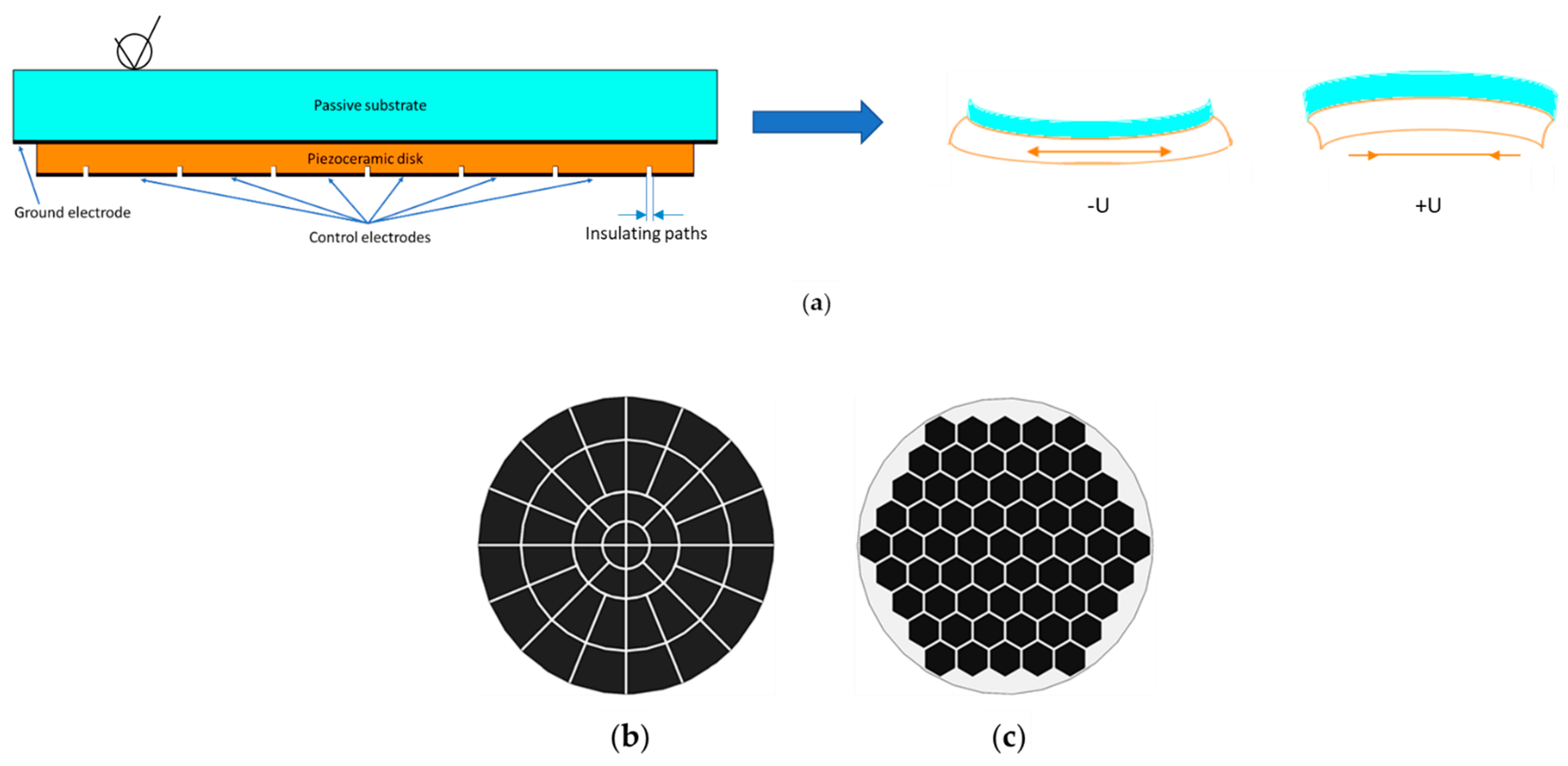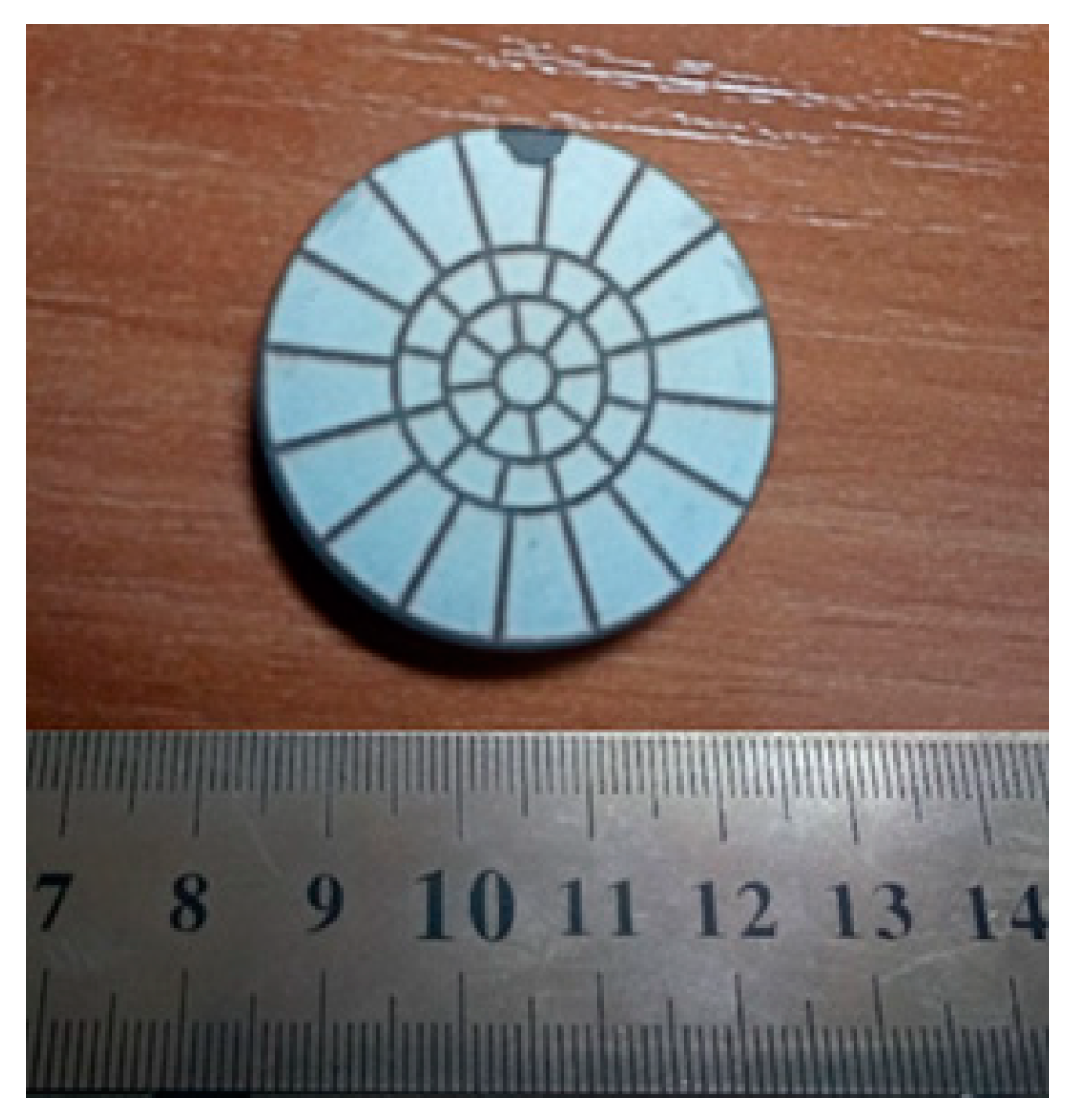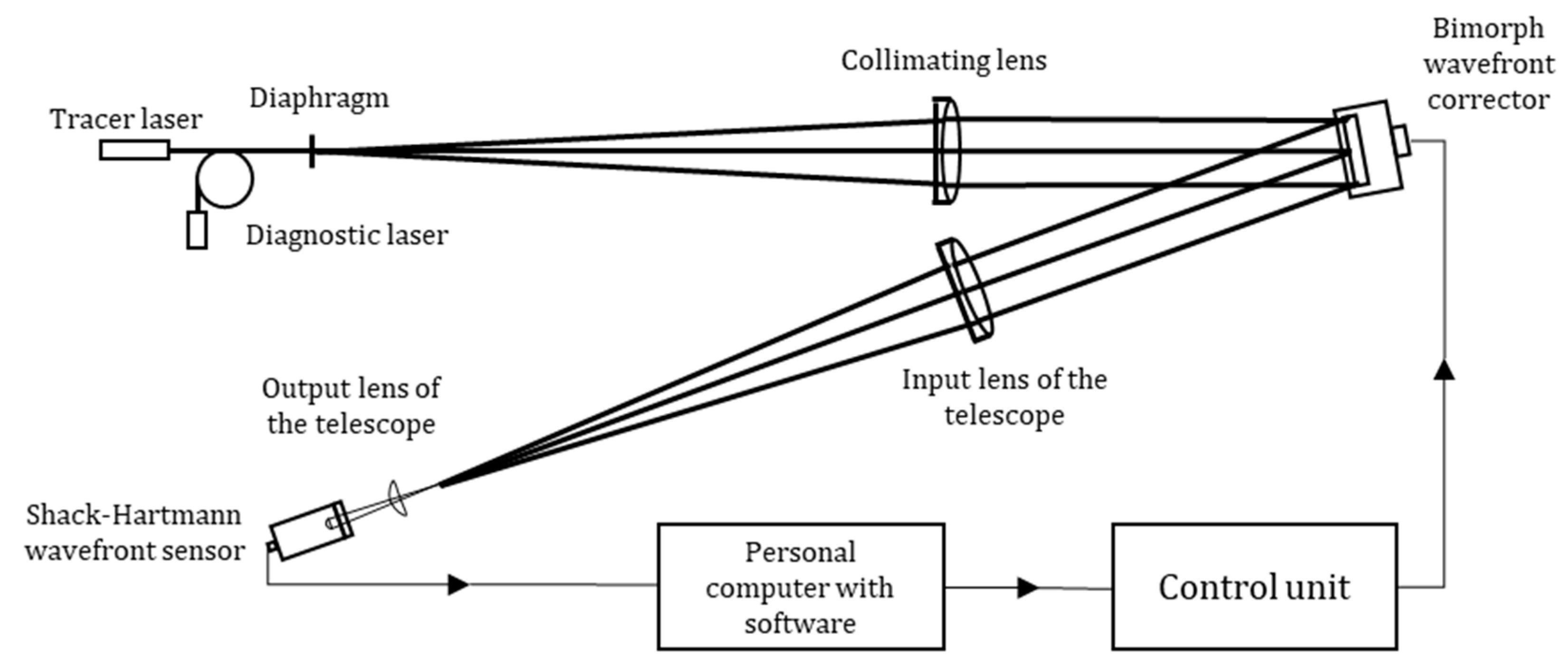State-of-the-Art Technologies in Piezoelectric Deformable Mirror Design
Abstract
:1. Introduction
2. Materials and Methods
3. Results and Discussion
4. Conclusions
Author Contributions
Funding
Institutional Review Board Statement
Informed Consent Statement
Data Availability Statement
Conflicts of Interest
References
- Bendek, E.; Lynch, D.; Pluzhnik, E.; Belikov, R.; Klamm, B.; Hyde, E.; Mumm, K. Development of a miniaturized deformable mirror controller. Proc. SPIE 2016, 9909, 990984. [Google Scholar] [CrossRef] [Green Version]
- Divoux, C.; Cugat, O.; Basrour, S.; Mounaix, P.; Kern, P.Y.; Boussey-Said, J. Miniaturized deformable magnetic mirror for adaptive optics. Proc. SPIE 1998, 3353, 850–857. [Google Scholar] [CrossRef]
- Toporovsky, V.; Kudryashov, A.; Samarkin, V.; Panich, A.; Sokallo, A.; Malykhin, A.; Skrylev, A.; Sheldakova, J.V. Small-aperture stacked-array deformable mirror made of the piezoceramic combs. Proc. SPIE 2021, 11672, 1167215. [Google Scholar] [CrossRef]
- Sato, T.; Ishida, H.; Ikeda, O. Adaptive PVDF piezoelectric deformable mirror system. Appl. Opt. 1980, 19, 1430–1434. [Google Scholar] [CrossRef]
- Wei, K.; Zhang, X.; Xian, H.; Ma, W.; Zhang, A.; Zhou, L.; Guan, C.; Li, M.; Chen, D.; Chen, S.; et al. First light on the 127-element adaptive optical system for 1.8-m telescope. Chin. Opt. Lett. 2010, 8, 1019–1021. [Google Scholar] [CrossRef]
- Kudryashov, A.; Rukosuev, A.; Nikitin, A.; Galaktionov, I.; Sheldakova, J. Real-time 1.5 kHz adaptive optical system to correct for atmospheric turbulence. Opt. Express 2020, 28, 37546–37552. [Google Scholar] [CrossRef]
- Bifano, T. MEMS deformable mirrors. Nat. Photonics 2021, 5, 21–23. [Google Scholar] [CrossRef]
- Moghimi, M.J.; Wilson, C.; Dickensheets, D.L. Electrostatic-pneumatic MEMS deformable mirror for focus control. In Proceedings of the 2012 International Conference on Optical MEMS and Nanophotonics, Banff, AB, Canada, 6–9 August 2012; pp. 132–133. [Google Scholar]
- Biasi, R.; Gallieni, D.; Salinari, P.; Riccardi, A.; Mantegazza, P. Contactless thin adaptive mirror technology: Past, present, and future. Proc. SPIE 2010, 7736, 77362B. [Google Scholar] [CrossRef]
- Toporovsky, V.V.; Kudryashov, A.V.; Samarkin, V.V.; Rukosuev, A.L.; Nikitin, A.N.; Sheldakova, Y.V.; Otrubyannikova, O.V. Cooled Stacked-Actuator Deformable Mirror for Compensation for Phase Fluctuations in a Turbulent Atmosphere. Atmospheric Ocean. Opt. 2020, 33, 584–590. [Google Scholar] [CrossRef]
- Samarkin, V.; Aleksandrov, A.G.; Jitsuno, T.; Romanov, P.N.; Rukosuev, A.L.; Kudryashov, A. Study of a wide-aperture combined deformable mirror for high-power pulsed phosphate glass lasers. Quantum Electron. 2015, 45, 1086–1087. [Google Scholar] [CrossRef]
- Lefaudeux, N.; Levecq, X.; Dovillaire, G.; Ballesta, J.; Lavergne, E.; Sauvageot, P.; Escolano, L. Development of a new tech-nology of deformable mirror for ultra-intense laser applications. Nucl. Instrum. Methods Phys. Res. Sect. A Accel. Spectrometers Detect. Assoc. Equip. 2011, 653, 164–167. [Google Scholar] [CrossRef]
- Salinari, P.; Del Vecchio, C.; Biliotti, V. A study of an adaptive secondary mirror. In Proceedings of the ICO-16 (International Commission for Optics) Satellite Conference on Active and adaptive optics, Garching/Munich, Germany, 2–5 August 1993; p. 247. [Google Scholar]
- Lück, H.; Müller, K.-O.; Aufmuth, P.; Danzmann, K. Correction of wavefront distortions by means of thermally adaptive optics. Opt. Commun. 2000, 175, 275–287. [Google Scholar] [CrossRef] [Green Version]
- Ivanova, N.L.; Onokhov, A.P.; Chaika, A.N.; Resnichenko, V.V.; Yeskov, D.N.; Gromadin, A.L.; Feoktistov, N.A.; Beresnev, L.A.; Pape, D.R. Liquid-crystal spatial light modulators for adaptive optics and image processing. Proc. SPIE 1996, 2754, 180–185. [Google Scholar] [CrossRef]
- Samarkin, V.V.; Alexandrov, A.; Toporovsky, V.; Rukosuev, A.; Kudryashov, A. Water-cooled deformable mirrors for high power beam correction. Proc. SPIE 2021, 11849, 1184917. [Google Scholar] [CrossRef]
- Riaud, P. New high-density deformable mirrors for high-contrast imaging. Astron. Astrophys. 2012, 545, A25. [Google Scholar] [CrossRef] [Green Version]
- Cornelissen, S.A.; Bifano, T.G.; Bierden, P.A. MEMS deformable mirror actuators with enhanced reliability. Proc. SPIE 2012, 8253, 47–53. [Google Scholar] [CrossRef]
- Oya, S.; Bouvier, A.; Guyon, O.; Watanabe, M.; Hayano, Y.; Takami, H.; Iye, M.; Hattori, M.; Saito, Y.; Itoh, M.; et al. Performance of the deformable mirror for Subaru LGSAO. Proc. SPIE 2006, 6272, 62724S. [Google Scholar]
- Alaluf, D.; Bastaits, R.; Wang, K.; Horodinca, M.; Martic, G.; Mokrani, B.; Preumont, A. Unimorph mirror for adaptive optics in space telescopes. Appl. Opt. 2018, 57, 3629–3638. [Google Scholar] [CrossRef]
- Kudryashov, A.V.; Kulakov, V.B.; Kotsuba, Y.V.; Novikova, L.V.; Panchenko, V.Y.; Samarkin, V.V. Low-cost adaptive optical devices for multipurpose applications. Proc. SPIE 1999, 3688, 469–476. [Google Scholar] [CrossRef]
- Galaktionov, I.; Sheldakova, J.; Nikitin, A.; Samarkin, V.; Parfenov, V.; Kudryashov, A. Laser beam focusing through a mod-erately scattering medium using a bimorph mirror. Opt. Express 2020, 28, 38061–38075. [Google Scholar] [CrossRef]
- Kudryashov, A.; Alexandrov, A.; Rukosuev, A.; Samarkin, V.; Galarneau, P.; Turbide, S.; Châteauneuf, F. Extremely high-power CO2 laser beam correction. Appl. Opt. 2015, 54, 4352–4358. [Google Scholar] [CrossRef] [PubMed]
- Wattellier, B.; Fuchs, J.; Zou, J.-P.; Chanteloup, J.C.; Bandulet, H.; Michel, P.; Labaune, C.; Depierreux, S.; Kudryashov, A.; Aleksandrov, A. Generation of a single hot spot by use of a deformable mirror and study of its propagation in an underdense plasma. J. Opt. Soc. Am. B 2003, 20, 1632–1642. [Google Scholar] [CrossRef]
- Samarkin, V.; Aleksandrov, A.; Dubikovsky, V.; Kudryashov, A. Water-cooled bimorph correctors. Proc. SPIE 2005, 6018, 60180Z. [Google Scholar] [CrossRef]
- Ahn, K.; Rhee, H.-G.; Yang, H.-S.; Kihm, H. CVD SiC deformable mirror with monolithic cooling channels. Opt. Express 2018, 26, 9724–9739. [Google Scholar] [CrossRef]
- Cholleti, E.R. A Review on 3D printing of piezoelectric materials. IOP Conf. Series Mater. Sci. Eng. 2018, 455, 012046. [Google Scholar] [CrossRef]
- Hall, S.E.; Regis, J.E.; Renteria, A.; Chavez, L.A.; Delfin, L.; Vargas, S.; Haberman, M.R.; Espalin, D.; Wicker, R.; Lin, Y. Paste extrusion 3D printing and characterization of lead zirconate titanate piezoelectric ceramics. Ceram. Int. 2021, 47, 22042–22048. [Google Scholar] [CrossRef]
- Hickey, G.; Barbee, T.; Ealey, M.; Redding, D. Actuated hybrid mirrors for space telescopes. Proc. SPIE 2010, 7731, 773120. [Google Scholar] [CrossRef]
- Rausch, P.; Verpoort, S.; Wittrock, U. Unimorph deformable mirror for space telescopes: Design and manufacturing. Opt. Express 2015, 23, 19469–19477. [Google Scholar] [CrossRef]
- Neppiras, E. Ultrasonic welding of metals. Ultrasonics 1965, 3, 128–135. [Google Scholar] [CrossRef]
- Biele, L.; Schaaf, P.; Schmid, F. Specific Electrical Contact Resistance of Copper in Resistance Welding. Phys. Status Solidi Appl. Mater. Sci. 2021, 218, 2100224. [Google Scholar] [CrossRef]
- Chichkov, B.N.; Momma, C.; Nolte, S.; Von Alvensleben, F.; Tünnermann, A. Femtosecond, picosecond and nanosecond laser ablation of solids. Appl. Phys. A 1996, 63, 109–115. [Google Scholar] [CrossRef]
- Samarkin, V.V.; Alexandrov, A.G.; Galaktionov, I.V.; Kudryashov, A.V.; Nikitin, A.N.; Rukosuev, A.L.; Toporovsky, V.V.; Sheldakova, Y.V. Large-aperture adaptive optical system for correcting wavefront distortions of a petawatt Ti: Sapphire laser beam. Quantum Electron. 2022, 52, 187–194. [Google Scholar] [CrossRef]
- Tan, X.-C.; Wu, Z.-C.; Liang, Z. Effect of adaptive optical system on the capability of lidar detection in atmosphere. Proc. SPIE 2009, 7284, 72840G. [Google Scholar] [CrossRef]
- Weyrauch, T.; Vorontsov, M. Free-space laser communications with adaptive optics: Atmospheric compensation experiments. J. Opt. Fiber Commun. Rep. 2004, 1, 355–379. [Google Scholar] [CrossRef]
- Spalding, I. Electric-discharge pumping. High Power Laser Sci. Eng. 1996, 7, 27. [Google Scholar]
- Booth, M.J. Adaptive optical microscopy: The ongoing quest for a perfect image. Light. Sci. Appl. 2014, 3, e165. [Google Scholar] [CrossRef]
- Noll, R.J. Zernike polynomials and atmospheric turbulence. J. Opt. Soc. Am. 1976, 66, 207–211. [Google Scholar] [CrossRef]
- Verpoort, S.; Rausch, P.; Wittrock, U. Characterization of a miniaturized unimorph deformable mirror for high power CW-solid state lasers. Proc. SPIE 2012, 8253, 825309. [Google Scholar] [CrossRef]
- Zhu, Z.; Li, Y.; Chen, J.; Ma, J.; Chu, J. Development of a unimorph deformable mirror with water cooling. Opt. Express 2017, 25, 29916. [Google Scholar] [CrossRef]
- Arakelyan, S.M.; Veiko, V.P.; Kutrovskaya, S.V.; Kucherik, A.O.; Osipov, A.V.; Vartanyan, T.A.; Itina, T.E. Reliable and well-controlled synthesis of noble metal nanoparticles by continuous wave laser ablation in different liquids for deposition of thin films with variable optical properties. J. Nanoparticle Res. 2016, 18, 155. [Google Scholar] [CrossRef]
- Takaku, R.; Wen, Q.; Cray, S.; Devlin, M.; Dicker, S.; Hanany, S.; Hasebe, T.; Iida, T.; Katayama, N.; Konishi, K.; et al. Large diameter millimeter-wave low-pass filter made of alumina with laser ablated anti-reflection coating. Opt. Express 2011, 29, 41745–41765. [Google Scholar] [CrossRef]
- Chryssolouris, G. Laser Machining-Theory and Practice; Springer: New York, NY, USA, 1991; 274p. [Google Scholar]
- Patel, R.; Chaudhary, P.S.; Soni, D.K. A review on laser engraving process for different materials. Int. J. Sci.-Entific Res. Dev. 2015, 2, 1–4. [Google Scholar]
- Toporovskii, V.V.; Skvortsov, A.A.; Kudryashov, A.V.; Samarkin, V.V.; Sheldakova, Y.V.; Pshonkin, D.E. Flexible bi-morphic mirror with high density of control electrodes for correcting wavefront aberrations. J. Opt. Technol. 2019, 86, 32–38. [Google Scholar] [CrossRef]
- Babu, S.; Santella, M.; Feng, Z.; Riemer, B.; Cohron, J. Empirical model of effects of pressure and temperature on electrical contact resistance of metals. Sci. Technol. Weld. Join. 2001, 6, 126–132. [Google Scholar] [CrossRef]
- Reinert, W. Handbook of Silicon Based MEMS Materials and Technologies. Met. Alloy. Seal Bond. 2015, 1, 626–639. [Google Scholar]
- Sprigode, T.; Gester, A.; Wagner, G.; Mäder, T.; Senf, B.; Drossel, W.-G. Mechanical and Microstructural Characterization of Ultrasonic Welded NiTiCu Shape Memory Alloy Wires to Silver-Coated Copper Ferrules. Metals 2021, 11, 1936. [Google Scholar] [CrossRef]
- Kudryashov, A.V.; Samarkin, V.V.; Sheldakova, Y.V.; Aleksandrov, A.G. Wavefront compensation method using a Shack-Hartmann sensor as an adaptive optical element system. Optoelectron. Instrum. Data Process. 2012, 48, 153–158. [Google Scholar] [CrossRef]
- Sheldakova, J.; Kudryashov, A.; Lylova, A.; Samarkin, V.; Byalko, A. New approach for laser beam formation by means of deformable mirrors. In Laser Beam Shaping XVI; SPIE: Bellingham, WA, USA, 2015; Volume 9581, p. 95810. [Google Scholar] [CrossRef]
- Young, W.C. Roark's Formulas for Stress and Strain, 6th ed.; McGraw-Hill: New York, NY, USA, 1989; pp. 421–442. [Google Scholar]
- Ellis, E.M. Low-Cost Bimorph Adaptive Mirrors. PhD Thesis, Imperial College of Science, London, UK, 1999. [Google Scholar]
- Toporovsky, V.; Samarkin, V.; Sheldakova, J.; Rukosuev, A.; Kudryashov, A. Water-cooled stacked-actuator flexible mirror for high-power laser beam correction. Opt. Laser Technol. 2021, 144, 107427. [Google Scholar] [CrossRef]
- Samarkin, V.; Alexandrov, A.; Galaktionov, I.; Kudryashov, A.; Nikitin, A.; Rukosuev, A.; Toporovsky, V.; Sheldakova, J. Wide-Aperture Bimorph Deformable Mirror for Beam Focusing in 4.2 PW Ti: Sa Laser. Appl. Sci. 2022, 12, 1144. [Google Scholar] [CrossRef]







| Boundary Conditions | K |
|---|---|
| Simply constrained | 4.99 |
| Edge clamped | 10.2 |
| Edge free | 5.25 |
Publisher’s Note: MDPI stays neutral with regard to jurisdictional claims in published maps and institutional affiliations. |
© 2022 by the authors. Licensee MDPI, Basel, Switzerland. This article is an open access article distributed under the terms and conditions of the Creative Commons Attribution (CC BY) license (https://creativecommons.org/licenses/by/4.0/).
Share and Cite
Toporovsky, V.; Kudryashov, A.; Skvortsov, A.; Rukosuev, A.; Samarkin, V.; Galaktionov, I. State-of-the-Art Technologies in Piezoelectric Deformable Mirror Design. Photonics 2022, 9, 321. https://doi.org/10.3390/photonics9050321
Toporovsky V, Kudryashov A, Skvortsov A, Rukosuev A, Samarkin V, Galaktionov I. State-of-the-Art Technologies in Piezoelectric Deformable Mirror Design. Photonics. 2022; 9(5):321. https://doi.org/10.3390/photonics9050321
Chicago/Turabian StyleToporovsky, Vladimir, Alexis Kudryashov, Arkadiy Skvortsov, Alexey Rukosuev, Vadim Samarkin, and Ilya Galaktionov. 2022. "State-of-the-Art Technologies in Piezoelectric Deformable Mirror Design" Photonics 9, no. 5: 321. https://doi.org/10.3390/photonics9050321
APA StyleToporovsky, V., Kudryashov, A., Skvortsov, A., Rukosuev, A., Samarkin, V., & Galaktionov, I. (2022). State-of-the-Art Technologies in Piezoelectric Deformable Mirror Design. Photonics, 9(5), 321. https://doi.org/10.3390/photonics9050321








